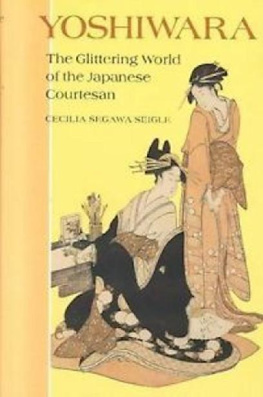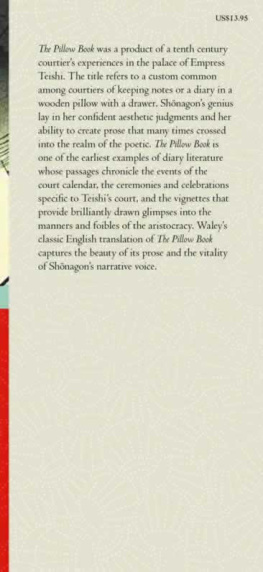Cecilia Segawa Seigle - Yoshiwara: The Glittering World of the Japanese Courtesan
Here you can read online Cecilia Segawa Seigle - Yoshiwara: The Glittering World of the Japanese Courtesan full text of the book (entire story) in english for free. Download pdf and epub, get meaning, cover and reviews about this ebook. year: 1993, publisher: University of Hawaii Press, genre: Non-fiction. Description of the work, (preface) as well as reviews are available. Best literature library LitArk.com created for fans of good reading and offers a wide selection of genres:
Romance novel
Science fiction
Adventure
Detective
Science
History
Home and family
Prose
Art
Politics
Computer
Non-fiction
Religion
Business
Children
Humor
Choose a favorite category and find really read worthwhile books. Enjoy immersion in the world of imagination, feel the emotions of the characters or learn something new for yourself, make an fascinating discovery.
- Book:Yoshiwara: The Glittering World of the Japanese Courtesan
- Author:
- Publisher:University of Hawaii Press
- Genre:
- Year:1993
- Rating:5 / 5
- Favourites:Add to favourites
- Your mark:
- 100
- 1
- 2
- 3
- 4
- 5
Yoshiwara: The Glittering World of the Japanese Courtesan: summary, description and annotation
We offer to read an annotation, description, summary or preface (depends on what the author of the book "Yoshiwara: The Glittering World of the Japanese Courtesan" wrote himself). If you haven't found the necessary information about the book — write in the comments, we will try to find it.
Yoshiwara: The Glittering World of the Japanese Courtesan — read online for free the complete book (whole text) full work
Below is the text of the book, divided by pages. System saving the place of the last page read, allows you to conveniently read the book "Yoshiwara: The Glittering World of the Japanese Courtesan" online for free, without having to search again every time where you left off. Put a bookmark, and you can go to the page where you finished reading at any time.
Font size:
Interval:
Bookmark:
After the death of Toyotomi Hideyoshi in 1598, his daimyo divided into three groups: the supporters of the young and weak Toyotomi heir, Hideyori; the daimyo rallying around Tokugawa Ieyasu, head of eight Kanto provinces and a consummate politician; and a number of daimyo who were uncommitted. Ieyasu had been patiently waiting for an opportunity to overturn the Toyotomi regime. He now emerged as the unrivaled head of the daimyo, by his superb military and political skills forcing the others to pay him obeisance. It was inevitable that the Toyotomi and Tokugawa factions would fight for control of Japan, and the victory of the Tokugawa forces at the fierce confrontation at Sekigahara in 1600 tipped the scale decisively. On the strength of this victory, Tokugawa Ieyasu obtained the title of shogun from the powerless titular emperor in 1603 and emerged as chief of all the daimyo. After a century of strife among various provincial daimyo, Japans unification was complete.
Ieyasus establishment of the shogunate and its government, the bakufu, set Japan on the final stage of feudalism and isolation. The bakufu devoted itself to stabilizing and perpetuating the position of the Tokugawa lineage at the helm of shogunate authority. In order to ensure peace and order in the nation, the bakufu built a highly structured social order and, in 1639, insulated the nation from foreign influence for the next two hundred and thirty years. It also set the stage for the appearance of the Yoshiwara.1
Building Edo
Armed with the new title of shogun, Ieyasu made Edo Castle the seat of his government and set about building a city befitting its role as the shoguns central headquarters. The thousands of samurai required for protection of the new regime gathered in Edo. Thousands of laborers poured in for the tasks of fortifying the castle, leveling the Kanda hill to create flat land, filling in low-lying river and coastal areas, and building roads, towns, and mansions for the daimyo.1 What had in 1500 been a small fishing village of less than 1,000 people exploded into a new urban center with a population swelling to 150,000 by the first decades of the 1600s. This figure doubled and tripled in the next several decades, exceeding one million in the eighteenth century.
Economically, Edo was predominantly a city of samurai. To secure his hegemony, Ieyasu devised a clever system which came to be known as sankin kotai (alternative-year residence). According to this system, the daimyo whose domains were located close to Edo were required to spend half of each year in Edo to serve at the shogunal court. Daimyd who were enfeoffed farther from Edo were required to stay in Edo every other year. In both cases, approximately two soldiers per 100 koku of fief accompanied daimyo to Edo to provide an army for the shogun. The costly travel to and from Edo and the heavy spending on public works assigned by Ieyasu kept the daimyo financially weak and unable to revolt. In 1635, his grandson third shogun Iemitsu made sankin kotai a law governing all daimyo, and the succeeding shogun continued the practice of transferring to daimyo the responsibility of public construction projects, including some of Tokugawas private temples and villas.
The families of all the daimyo, as well as those of a few vassals in perpetual assignment in Edo, remained permanently in their Edo residences as semihostages of the bakufu. Most vassals families, however, were kept in the daimyos home domain. This system imposed involuntary if temporary bachelorhood on the men while they were serving in Edo. Samurai vassals who belonged directly to the shogun were permanent residents of Edo; most of these were bachelors, unable to support a family on their salaries until their positions and income were advanced. As the city also needed a vast support group of merchants to provide the samurai class with their daily necessities, thousands of merchants from the Kansai region opened branch stores in Edo. During the seventeenth century the majority of merchants, especially those from the provinces of Ise and Omi who were known for their aggressiveness and shrewdness, were temporary residents of Edo who did not plan to build a family there but sent their earnings to their provincial home offices. Like their samurai customers, the merchants and their employees either had their families in the provinces or could not afford wives. Thus Edo was overcrowded with wifeless men of all ages.
Izumo no Okuni and Kabuki
In 1603, on the grounds of the Kitano Shrine in Kyoto, a crowd of people stood in front of a makeshift stage upon which a woman danced. The woman was Izumo no Okuni.3 The crowd applauded enthusiastically as she performed such dances as the yayako odori (childrens dance) and the nenbutsu odori (prayer dance), folk dances embellished with Okunis own choreographic devices. These dances later came to be known as kabuki dances, kabuki being the recently coined word for anything outlandish or wild in mode of clothing or behavior, and Okuni being an outstanding example.
Okuni was a dancer and prostitute whose flair, originality, and daring soon made her name as famous as the shoguns. She said she had been a priestess of the famous Great Shrine in Izumo province, which had played an important role in the early history of Japan. She apparently was astute and ambitious enough to give herself an aura of mystery and respectability that her real background did not afford. The fact that she had danced the popular yayako dance in Naras Kasuga Shrine in 1582 suggests that she was not from Izumo, as she claimed, but rather was a native of the Kansai region.
Accounts of her performances attest to a strange and disturbing quality that appealed to the spectators. In a typical performance, she would first dress herself in a black monkish robe. As she danced, she would strike a small bell and sing in a resonant voice. She wore a Christian cross on her chest, not as a mark of faith but as an exotic accessory. Her audacity in this action is all the more striking when one considers the prevailing attitude toward Christianity at the time. Although the most severe persecutions of
Christians did not occur until 1612 to 1635, already in 1596 some twenty-six Christians in Nagasaki, including several foreign missionaries, had been crucified by the order of Hideyoshi. In Okunis time, though a cross was considered a fashionable design, it was not prudent to adorn oneself with Christian symbols. Okuni also frequently wore the augustly dignified masculine headgear and white ceremonial robe of a Shinto priest or, by contrast, in a gorgeous and thoroughly feminine kimono danced with a male partner. But the most popular part of her program was when she took the role of a young man, wearing brocade trousers and the animal skin jacket favored by fashionable daimyo and dandies. The audience, undoubtedly shocked and titillated by the sexual reversal, cheered and applauded wildly, especially when in this outfit she acted as a young man flirting with a teahouse woman or visiting a courtesan.
Okunis sensational success produced a number of imitators. Many courtesans from the licensed quarter of Misujimachi in Kyoto followed her example and performed dances and stately no dramas in strange costumes, some being invited to entertain in aristocratic houses. On such occasions, an announcement would often be made identifying the dancer, along with her bordello, as the days tayu, the top-billed performer.4 Thus the term tayu, originally a court rank and more recently a star performer in no, shirabyoshi dance, or musical entertainment, evolved into a designation for the top rank among courtesans.
The secret of success of these prostitute/dancers was partly timing. There had been over two centuries of civil war, destruction, pillaging, starvation, and untimely deaths of loved ones. The populace was hungry for peace, and for pleasure and pleasant diversion, symbolized by the dazzling appearance and luxurious soft silk kimono of beautiful women. Evidence of the populaces longing for distraction from day-to-day misery can be seen in the success of Kyotos pleasure quarter, which had been thriving since 1589, when Toyotomi Hideyoshi authorized its establishment.
Font size:
Interval:
Bookmark:
Similar books «Yoshiwara: The Glittering World of the Japanese Courtesan»
Look at similar books to Yoshiwara: The Glittering World of the Japanese Courtesan. We have selected literature similar in name and meaning in the hope of providing readers with more options to find new, interesting, not yet read works.
Discussion, reviews of the book Yoshiwara: The Glittering World of the Japanese Courtesan and just readers' own opinions. Leave your comments, write what you think about the work, its meaning or the main characters. Specify what exactly you liked and what you didn't like, and why you think so.












